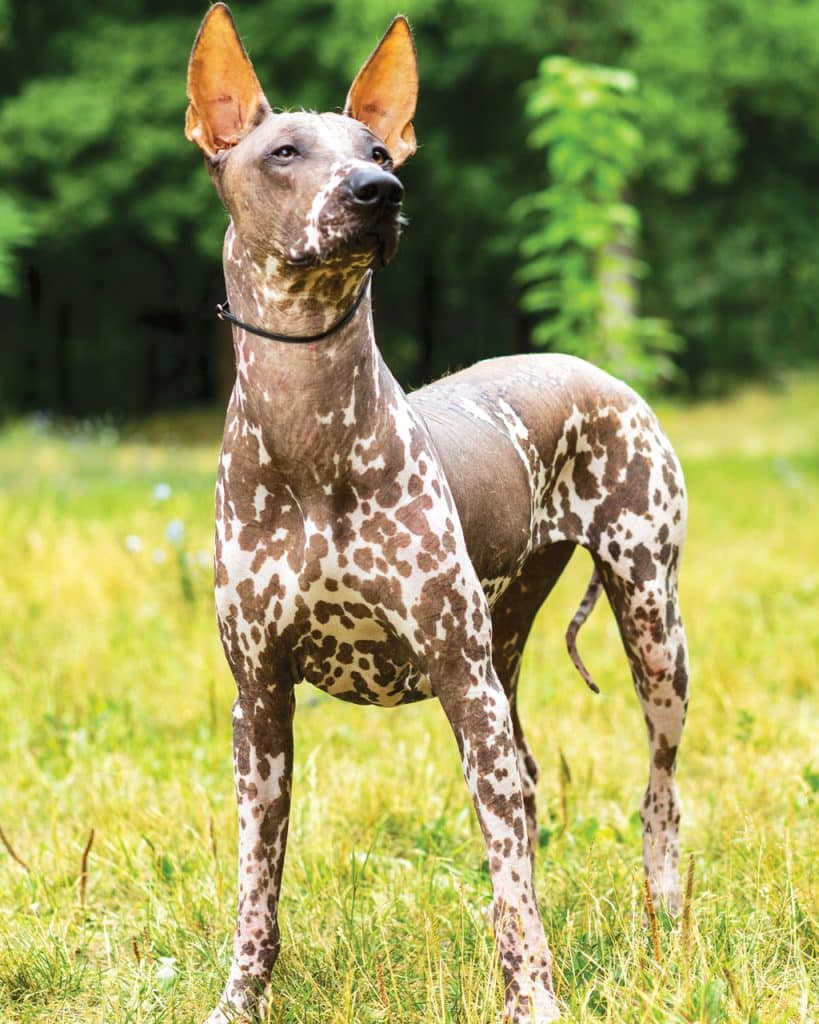With their unique, often hairless appearance, the Xoloitzcuintli, or simply Xolo, stands out as one of the most intriguing dog breeds in the world. But beyond their striking looks lies a history as rich and fascinating as Mexican culture itself. Is this ancient breed the right companion for you? Let’s delve into the captivating world of the Xoloitzcuintli.
Pronouncing Xoloitzcuintli: A Linguistic Adventure
The name Xoloitzcuintli might seem like a tongue-twister at first glance. Pronounced “show-low-eats-queent-lee,” it originates from the Nahuatl language, the language of the Aztecs. “Xolotl” refers to the Aztec god of fire and lightning, often associated with life and death, while “itzcuintli” simply translates to “dog.” For ease of use, and in everyday conversation, this remarkable breed is most commonly known as the Xolo. You might even recognize a Xolo in popular culture, like the lovable and somewhat clumsy dog in Pixar’s animated film Coco, which brought this iconic Mexican dog breed to a global audience.
Xoloitzcuintli: Tracing the Origins of the Mexican Hairless Dog
Outside of Mexico and Central America, the Xoloitzcuintli is often considered a rare and exotic breed. As a primitive, natural breed, the Xolo’s development wasn’t dictated by human aesthetics or specific tasks. They evolved naturally over millennia, shaped by their environment and natural selection. This makes them a living link to the distant past.
But where exactly did this breed originate? While pinpointing the exact origins of any ancient breed involves some educated guesswork, substantial evidence points to the Xoloitzcuintli being a uniquely Mexican dog breed. Archaeological findings at Aztec sites have unearthed skeletal remains remarkably similar to modern Xolos, dating back over 3,000 years. Furthermore, ancient art and artifacts discovered in Mayan, Toltec, Zapotec, and Colima Indian tombs depict dogs with unmistakable Xolo features. This rich archaeological record firmly establishes the Xoloitzcuintli as a breed deeply rooted in Mexican history and pre-Columbian cultures.
 Xoloitzcuintli dog
Xoloitzcuintli dog
A classic representation of a Xoloitzcuintli dog, showcasing its distinctive hairless body and elegant posture.
The Sacred Status of the Xoloitzcuintli in Ancient Cultures
The Xoloitzcuintli held a profound cultural significance in ancient Mexican and Central American societies. The Aztecs and Mayans revered these dogs as sacred creatures, believing they were created by the god Xolotl himself and imbued with mystical powers to ward off malevolent spirits. Beyond protection, Xolos were believed to act as spiritual guides, assisting the deceased on their journey to Mictlan, the underworld. This sacred role led to the practice of sacrificing Xolos and burying them alongside their owners, ensuring a continued bond and safe passage into the afterlife.
This deep cultural connection to the Xoloitzcuintli has transcended time. Even in modern Mexico, the breed remains a powerful symbol of national heritage. Renowned Mexican artists Diego Rivera and Frida Kahlo were passionate Xolo owners and frequently featured them in their iconic artwork, further cementing the breed’s cultural importance.
The Xoloitzcuintli’s journey beyond Mexico began in 1887 when it was first registered with the American Kennel Club (AKC) as the “Mexican Hairless.” Despite this initial recognition, the breed remained exceedingly rare in the United States, leading to a decline in numbers and its delisting by the AKC in the 1950s.
However, dedicated Xolo enthusiasts recognized the breed’s precarious situation and embarked on expeditions to remote regions of Mexico to locate and preserve archetypal specimens. Their efforts led to the recovery of ten Xolos that met the desired breed standard, revitalizing the lineage. The Mexican Kennel Club (FCM) officially recognized the breed in 1956, but it wasn’t until 2011 that the AKC re-accepted the Xoloitzcuintli, marking a resurgence in its popularity and recognition in North America. It’s important to note that while famously hairless, there are actually two varieties of Xolos: hairless and coated, adding to the breed’s genetic diversity.
Xoloitzcuintli Size, Appearance, and Unique Traits
Today, the AKC recognizes the Xoloitzcuintli in three distinct sizes: Toy, Miniature, and Standard. Toy Xolos stand between 10 to 14 inches tall at the shoulder, Miniatures range from 14 to 18 inches, and Standards reach 18 to 23 inches. Across all sizes, the Xolo exhibits a sleek and elegant physique, characterized by almond-shaped eyes that convey intelligence and alertness, a long, refined muzzle, and large, expressive ears. Their appearance shares some resemblance with breeds like the Pharaoh Hound, but it is their lack of hair that truly sets them apart.
While the name “Mexican Hairless Dog” suggests complete hairlessness, most Xoloitzcuintlis are predominantly hairless but often sport short tufts of hair on their head, feet, and tail tip. Interestingly, approximately 20% of Xolos are born with a short, smooth coat of fur. The AKC breed standard favors dark, solid coat colors, including black, grey-black, slate, red, liver, and bronze.
The increased visibility of the Xoloitzcuintli in recent years can be partly attributed to the popular Pixar film Coco. “Dante,” the animated Xolo character, is a goofy yet endearing sidekick, perfectly capturing the breed’s playful and loyal nature. His prominent role in a film centered around Dia de los Muertos (Day of the Dead), a significant Mexican holiday, further highlights the Xolo’s deep cultural connection to Mexico.
Beyond their historical and cultural significance, Xolos make wonderful companion animals. They are known for their calm, affectionate, and playful temperament. Xoloitzcuintlis are generally quiet dogs, naturally clean, and thrive on close companionship with their families. They are true cuddle enthusiasts, and their unique physiology makes them exceptional warmers – Xolos radiate a noticeable amount of body heat, often likened to a living hot-water bottle! This natural heat emission is speculated to be linked to the ancient belief in their mystical healing abilities.
Xoloitzcuintli Breed Profile: At a Glance
Size: Small to Medium. Xolos come in Toy, Miniature, and Standard sizes, ranging from 10 to 23 inches in height and 10 to 50 pounds in weight. Both hairless and coated varieties exist.
Activity Level: Moderate (3/5). While athletic, Xolos are content with daily walks and playtime at home.
Grooming: Moderate (3/5). Hairless varieties require regular bathing and moisturizing to maintain skin health.
Breed Group: Non-Sporting. As a primitive, natural breed, they served as hunting and family companions in Mexico and Central America.
For Xolo rescue information in the US and Canada, visit: xoloitzcuintliclubofamerica.org/xolo-rescue
Xoloitzcuintli Energy and Exercise Needs
Despite their love for cuddling and lounging, Xolos are not sedentary dogs. They possess a surprising level of athleticism and agility, stemming from their history as hunting dogs for small game. This “wild child” heritage means they retain a natural prey drive and may be inclined to chase smaller animals. Their agility also makes them adept jumpers and climbers, so a securely fenced yard is recommended for Xolo owners to prevent escapes.
Training Your Xoloitzcuintli
Early training is crucial for developing a well-behaved Xolo companion. They are intelligent dogs but also sensitive. Positive reinforcement training methods are highly effective and the most ethical approach for this breed, and indeed for all dogs. Xolos are quick learners and eager to please their owners. Consistency and firmness are important in training, but patience and kindness are paramount for this special breed.
Xoloitzcuintli Health Considerations
Xolos are generally a robust breed, but their lack of fur necessitates specific care considerations. Their skin needs regular washing and moisturizing to prevent dryness, and they are susceptible to sunburn, requiring sun protection. Another unique health aspect is that Xolos are born with an incomplete set of teeth, making dental hygiene a vital part of their care. On a positive note for allergy sufferers, Xolos are often well-tolerated by individuals with dog allergies.
The Xoloitzcuintli is a testament to the rich cultural heritage of Mexico and Central America. From mystical healer to spiritual guide in ancient legends, the Xolo’s endearing nature has ensured its enduring appeal. With their simple needs and deep desire for companionship, the Xoloitzcuintli has rightfully earned its iconic status as a national treasure and a remarkable dog breed.
If the Xoloitzcuintli interests you, consider exploring these breeds:
- Peruvian Inca Orchid
- American Hairless Terrier
- Basenji
» Explore More Breeds: Discover additional dog breed profiles at moderndogmagazine.com/breeds
